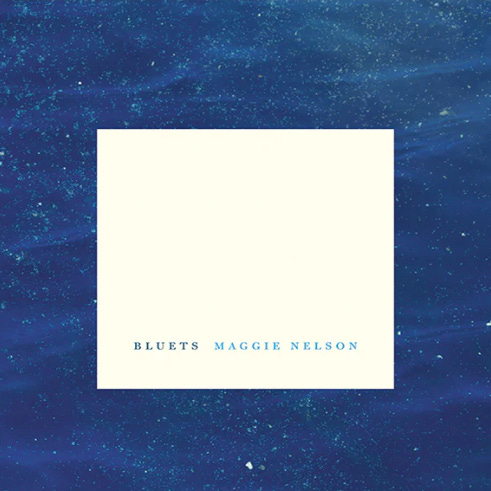Book Review: "Bluets" by Maggie Nelson
Exploring craft and contemporary form.
Book: Bluets
Author: Maggie Nelson
Publication Date: 2009
Publisher: Wave Books
Where To Buy: Wave Books
“Suppose I were to begin by saying that I had fallen in love with a color.”
Last April I found myself in the National Gallery in London, completely mesmerized by Paul Delaroche’s 1833 oil painting, The Execution of Lady Jane Grey.
Surrounded by bustling schoolchildren and tired tourists, I stood and stared—like a car-wreck rubber-necker—analyzing every detail, not of her imminent and grotesque beheading, but of the exquisite folds of the white satin dress she was wearing while it was to happen.
It was this same captivation I felt while reading Maggie Nelson’s raw and unfiltered book Bluets.
Form and Structure
This “poetry” book—without contents, foreword, or introduction—simply opens with the line:
“Suppose I were to begin by saying that I had fallen in love with a color.” (1)
What follows are 240 numbered prose stanzas, ending only with the quiet date stamp (2003-2006). I devoured it, loved it, hated it, threw it across the room — twice — and still find my mind returning to it often.
One of the most interesting craft aspects is Nelson’s braiding of multiple themes, all somehow loosely linked to the color or experience of blue, until they paint a complete picture.
It is as though Nelson didn’t know exactly what she was painting while writing—she just knew the hues emerging were the ones needed for the larger composition.
Braiding and Leapfrogging Themes
Each stand-alone stanza engages a specific thread—betrayal, depression, love, philosophy, or the psychology of blue; the science of sight and color; the different experiences between men and women.
In stanza 86, for example:
“The implication of the title is that men get blue, but women get the deepest blue.” (33)
Nelson “leap-frogs” through these ideas, reviving earlier threads almost imperceptibly—truly taking Dickinson’s line “Tell all the truth but tell it slant” to heart—until the final picture comes into view.
To make these transitions smooth, Nelson often uses homonyms to bridge seemingly unrelated stanzas.
Between #80 and #81, the speaker moves from superstition around the mines of Sar-e-Sang—where the Taliban in 2000 blew up two giant Buddhas whose blue auras were the “oldest-known application of lapis on earth” (31)—to the miners’ use of dynamite to “bleed a vein … in hopes of starting a ‘blue rush.’” (31)
Immediately we pivot to an echo of an earlier relationship:
“What I know: when I met you, a blue rush began. I want you to know, I no longer hold you responsible.” (31)
Another callback appears in stanza #230, when the speaker recounts being in the north country in May:
“I counseled myself. Love the one you’re with. Love the colour green. But I did not love the green.” (93)
—a return to stanza #145, where “Joan Mitchell … found the green of spring incredibly irritating … and preferred to live perpetually in ‘l’heure de bleu.’” (56-57)
The Body and Shock
Another thread concerns the speaker’s relationship to sex—at times so graphic it feels driven by pain more than craft.
In stanza #62 she writes:
“For my part I have no interest in catching a glimpse of or offering you an unblemished ass or an airbrushed cunt. I am interested in having / three orifices stuffed full of thick, veiny cock in the most unforgiving of poses and light.” (24)
To me, this level of explicitness is like throwing fluorescent pink onto a canvas painted in subtle winter hues—great shock factor, perhaps, but to the detriment of the overall work.
Intellect and Witness
Nelson often references white-male philosophers—Emerson, Milton, Goethe, Byron, Wittgenstein—examining their thoughts on blue, sight, and experience.
At times, it feels as though she seeks external validation, lending academic weight to her own experience.
Fascinating, yes, but sometimes overused—especially beside the more visceral, sexual stanzas.
By contrast, the thread about the friend paralyzed in an accident is the most affecting.
Here Nelson transcends citation and moves into genuine witnessing:
218. “As her witness, I can testify to no reason, no lesson [for the accident]. But I can say this: in watching her, sitting with her, helping her, weeping with her, touching her and talking with her, I have seen the bright pith of her soul. I cannot tell you what it looks like, exactly, but I can say I have seen it.” (89)
219. “Likewise, I can say that seeing it has made me a believer, though I cannot say what, or in what, exactly, I have come to believe.” (89)
These passages feel earned—moments where philosophy and feeling align.
Conclusion
Bluets expanded my perception of what is possible in and as poetry.
It planted in me the seed of an ambitious, epic project—one that, through the act of living into its writing, would change my belief in what is possible.
Works Cited
Nelson, Maggie. Bluets. Wave Books, 2009.
“Tell All the Truth but Tell It Slant — (1263).” The Poetry Foundation
“The Execution of Lady Jane Grey.” Wikipedia
Śivani Howe is a poet and teacher obsessed with Eco-poetry and spiritual poetics, good food, and trees. She is author of the poetry collection – THIS Is Written in the Stars – which gained #1 Hot New Release in Poetry (Amazon, 2024). She’s studying for her Masters in Poetry at Pacific Oregon University and has been featured in The Poetry Lighthouse II, Upon Learning That Anthologies, and IHRAM Press: their Enduring Voices (2025, Quarter 3). She resides with her family in the Purcell Mountains of British Columbia, Canada and believes that reconnecting and coming into right relationship with Land’s spirit is the fastest way to heal the human heart.
The Inkwell is published by Ink & Ribbon Press — a nonprofit poetry publisher dedicated to craft, discovery, and the permanence of the printed word.




